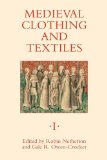|
Illustrations demonstrating the evolution of the style of sleeve-streamer which re-enactors commonly call a “tippet.” (As discussed over on the Canterbury Tales garment-name page, Chaucer uses the word typet to mean the long tail of a hood rather than a sleeve decoration.) See Tippets & Lappets: The arm accessories of the late 14th century for additional discussion.
In this set of links, I am choosing to focus on examples which are clearly not the “integral tippet” or pendant-style sleeve which appears in the Romance of Alexander (Bodley 264), the Taymouth Hours (Yates Thompson 13), the Smithfield Decretals (Royal 10 E IV), the Luttrell Psalter (Additional 42130), or the Braunche memorial brass.
It is interesting to note that the width and placement of the tippet, or sleeve streamer, seems to change somewhat, but I don't know whether this is a matter of preference, artistic convention, or regional (or temporal) changes in fashion. They appear on women more frequently than they do on men (though they appear on both men and women in BNF Fr. 1586, BNF Fr. 1584, BNF NAF 5243, and Yates Thompson 21). In color illustrations, white seems to be the color that appears most often, but some of the examples below include red or green. Some illustrations, especially in the later 14th and early 15th century, seem to show a more broad streamer with a fur texture, though the relative lack of texture or thickness/depth in other illustrations suggest that others may have been made of fabric. I have found no evidence indicating that these streamers would be worn while wearing a sideless surcoat.
For another point of view, see “The Tippet: Accessory after the Fact?” in Medieval Clothing and Textiles I.
Alia notanda pauca bona hoc anno [1344] fuerunt. Anglici tum insaniae alienigenarum adhaerentes velut de adventu Hannonesium, annis qasi xviii praeelapsis, annuatim varias deformitates vestium mutantes, longorum largorumque indumentorum antiqua onestate deserta, vestibus curtis, strictis, frustratis, scissis, omni parte laqueatis, corrigiatis, botonatis cum manicis ac tipeitis supertunicarum et caputiorum nimis pendulis, tortoribus et, ut verius dicam, daemonibus tam indumentis quam calciamentis similiores quam hominibus. Et si clerici seu religiosi alquibus dictorum usi sunt, non regulares sed irregulares judicentur. Mulieres einim in praedictis et aliis curiosius fluxerunt, adeo stricte vestitae, ut ad anos celandos caudas vulpinas vestibus inferius consutas pedernt. Quorum forte superbia futuris praetendit infortunia.
Chronica Johannis de Reading et Anonymi Cantuariensis
In þis tyme, Englisshe men so muche hauntted and cleuyd to þe wodnes and foley of þe strangers, þat fro þe tyme of þe comyng of þe Henauderns, xviij. ȝere passid, þey ordeyned and chaungyd ham euery ȝere diuers schappis of disgyngeȝ of cloþing, of long large and wyde cloþis, desitu and desert fram al honeste and good vsage; & anoþer tyme schorte cloþis & stret-wasted, dagged & ket, & on euery sde desslatered & boned, wiþ slenes & tapets of sircotys, & hodeȝ ouere longe & large; & ouermuche hangynde, þat if y soþ schal say, þey were more liche to turmentours & deuels in hire cloþing & schewyng & oþer arraye þen comen.
The Brut, ch. CCXXVII - Fols.
1r,
1v,
3r,
9r,
10r,
17v,
21r,
23r,
24r,
28v,
30v,
32v,
33v,
35r,
36v,
37v,
38r,
38v,
39v,
40v,
41v,
42v,
43r,
44v,
45v,
46v,
48r,
51r,
et al., from a collection of works of Guillaume de Machaut (BNF Fr. 1586), c. 1350-1355
- Interesting dagging on the streamers on a male donor in the Adoration of the Magi (MMW 10 A 4, fol. 27v), c. 1350-1366
- Interesting fur detail on one of the kings playing a game, Guiron le Courtois (British Library Additional 12228, fol. 23), c. 1352-1362
- Adoration of the Magi fresco at Vezzolano Abbey, c. 1354
- The wife on the memorial brass of Sir Miles Stapleton, 1364
- Roman de la Rose (University of Chicago Library MS 1380), c. 1365. Examples here show a white tippet on a solid-colored sleeve, and only depicted on women; the gowns also have a set of fitchets in the front. See 20, 21, 22, 23, 25, 26, 27, 48, 52, 53, 56, 65, 74, 171, 173, 175, 203, 286
- Fur tippets on women in fols. 25r and 28r in Historia destructionis Troiae (Bodmer 78), 1370
- Memorial brass of Isabel Beaufo, 1370
- Joan Cobham on the memorial brass of Sir John de la Pole, 1370
- Fol. 119 from the Weltchronik of Rudolf von Ems, BSB Cod. germ. 5, c. 1370; here, the streamers are clearly illustrated as ermine fur (see detail)
- Fols. 8r,
14r,
14v,
16r,
25r,
26r,
28v,
29r,
30v, 44r,
44v,
45r, 45v,
et al., in Guiron le Courtois (BNF NAF 5243), c. 1370-1380.
Some of these show the streamers in green or red, though most are apparently white.
- Memorial brass of Ismayne de Wynston, 1372
- Fols.
D,
1v,
9v,
54v,
73,
78v,
83v,
84,
84v,
85,
85v,
87,
87v,
88v,
91,
91v,
92,
92,
92v,
92v,
94v,
127v,
161v,
164v,
169,
169v,
et al., works of Guillaume de Machaut (BNF Fr. 1584), c. 1372-1377.
Interesting dagging on streamers (1v, 87, 91v).
- Ermentrude with Charles the Bald and the messengers, Grandes Chroniques de France (BNF Fr. 2813, fol. 149), c. 1375-1380 – an unusual example of colored (that is, clearly not white) streamers, but was it the illustrator’s decision to change them to red to contrast with the all-white clothing typical of this en grisaille manuscript?
- Fol. 152r, Grandes Chroniques de France (BNF Fr. 10135), c. 1375-1400
- Joan de la Tour, a weeper at the tomb of Edward III (d. 1377)
- Memorial brass of Joan Foxley, 1378
- Memorial brass of Maud Foxley, 1378
- Oyseuse admitting the Lover through the gates into the Garden of Pleasure (fol. 6v) and the dance of Mirth and Gladness (fol. 8v), Roman de la Rose (British Library Yates Thompson 21), c. 1380
- Memorial brass of Margaret Torrynton, 1380
- Memorial brass of Ysabeau de Blaisy, 1381
- The princess in a miniature of St. George, Legenda aurea (British Library Royal 19 B XVII), 1382
- Stefano Porro and his family (detail, different version?) in a fresco at the Oratorio di Santo Stefano at Lentate sul Seveso - note that the band connecting the tippet to the sleeve is quite wide; it seems to go all the way up to the top of the shoulder here.
- When Griseldis removes her gown in the L’Estoire de Griseldis myz par personnages (BNF Fr. 2203), 1395, we can see that the streamers seem to be part of the short-sleeved gown itself. In other illustrations from this manuscript (see screens 32, 34, 44, 54) it is unclear from the drawings whether the streamers are really part of a pendant sleeve on all of the dresses, or whether they are the same color as the gown’s sleeve.
I praise not, Dawe, the stremerse that thou herof spekest Bot of suche wide clothing, tateris and tagges,
It hirtith myn hert hevyly, I wil that thou it wite. Upland’s Rejoinder - Clovis I and his family (fol. 13v),
Louis II the Stammerer receives the Regalia (fol. 163),
the birth of Louis VIII (fol. 263v),
Grandes Chroniques de France (BNF Fr. 73), 14th-15th century.
These seem to lack the “band” we see around the arm in some earlier examples, and appear to be more like an extension of the gown’s sleeve. These streamers are also wider than some of the examples seen earlier in the 14th century. While the illustrator clearly uses a fur texture on some garments in this manuscript, the fur texture does not seem to appear on these streamers.
- Tippets and similar sorts of streaming sleeves appear on Liesse (Jubilation) (fol. 7v), Richesse (Wealth) (fol. 9v), and Reason (fols. 33v, 43r, 44v, 52r, and 52v), Roman de la Rose (BNF Fr. 12595), 14th-15th century
- Detail from the tapestry of Jourdain de Blaye in Padua, c. 1400
- April, Les très riches heures du Duc de Berry, 1412-1416; the texture seems to indicate that the streamers are made of white fur, and the overall shape is similar to that seen in BNF Fr. 73.
- Detail from the Retablo de la Virgen y San Jorge at the Iglesia de San Francisco, Villafranca del Penedés, Barcelona by Lluís Borrassà, c. 1400; also here
- Triptych of Mary and Child, St. Michael, and St. Catherine by Jan van Eyck, 1437; note that St. Catherine is wearing both fur tippets and a fur-topped surcoat, making this the only example I can think of with both tippets and a surcoat. However, Catherine is a princess-saint (hence the surcoat) and the mode of wrapping the streamers around her arms indicates the potential clumsiness of this combination of garments.
|



